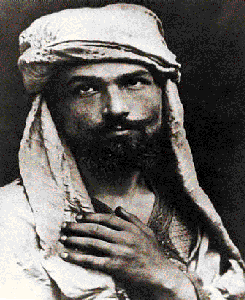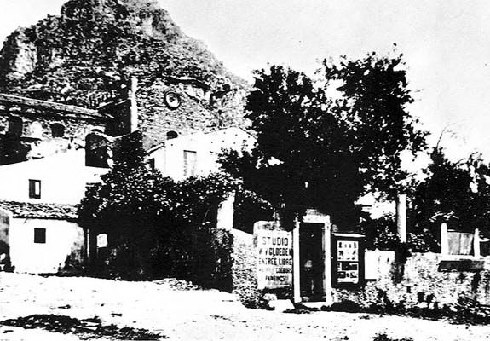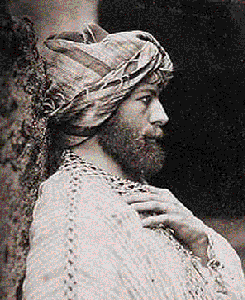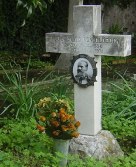Self-Portrait in a Turban
New Page 1
|
Many of the pictures were taken in the decade
before WWI when the artist was about 40 years old. Evidently he
adored the local culture. |
Self-Portrait in a Suit
A more formal picture
|
A more formal picture, taken 1891. It's hard to imagine him wearing
such attire on any average day. Not the clothes of a free spirit! |
Self-Portrait as Theatre
A more formal picture
|
This self-portraits
conveys well the defiance of a life lived freely, much as Oscar
Wilde did before the trial. |
IL Moro
A more formal picture
|
When the 23 y/o von Gloeden settled in Taormina, he was met by a 14
y/o whom the artist called Il Moro (The Moor). They remained lovers
for the next 51 years. |
Burial Place of Von Gloeden
16 February 1931 - Tacrmina
|
Wilhelm von Glúden
|
Wilhelm
von Glúden, Baron of the Court of the Hohenzollerns, was born in Schloss
Volkshagen, near Wiemar, in the Grand Duchy of Mecklenburg, a city on the
Baltic Sea in what is now Germany. His father, Baron Erminio von Glúden,
had married the widow of Herr von Raab and had died shortly after his birth.
His
mother re-married with Wilhelm Joachim von Hammerstein who was a well-known,
and well-to-do, journalist. His stepfather, also a Baron, was also a counsellor
and friend to Kaiser Wilhelm. Wilhelm von Glúden was thus raised a nobleman,
affluent and classically educated in the highest circles of the Prussian
elite. But Wilhelm had no interest in politics.
Instead,
he gave himself over to art and aesthetics. The study of ancient civilizations
was then more popular than at any time since the Renaissance, and Wilhelm
became a student of antiquity. After briefly studying art history (1876
- 1877), he turned to the study of painterly composition under Professor
C. Gehrts in Weimar, an education he was forced to break off prematurely
once diagnosed as suffering from tuberculosis.
Wilhelm
claimed to have been an illegitimate child in the family line of the Kaiser,
because of which he was persuaded to become an exile from his native land,
and for which exile he received a regular stipend from Berlin - on condition
that he never return.
In
reality, suffering from tuberculosis, at the time one of Europe's great
scourges, von Glúden was advised to seek a warmer, drier climate. While
recuperating at a Baltic sanatorium, von Glúden became acquainted with Otto
Geleng, a man involved in developing the tourist trade of Taormina, Sicily.
Geleng persuaded von Glúden to take up residence there in order to fully
convalesce from his illness. Wilhelm von Glúden's step-father provided him
the means to live in some splendour in Sicily.
He
settled in Taormina, a hillside town on the northeast coast of Sicily which
at the close of the nineteenth century was a small, impoverished Sicilian
town unknown to tourists, to regain his physical and mental health (the
psychological distress he experienced as a gay man unable to indulge his
erotic fantasies). Although von Glúden originally travelled to Italy for
reasons of health, he found there his "paradise on earth", as he himself
put it.
In
1876, after arriving in Taormina, which at the close of the nineteenth century
was a small, impoverished Sicilian town unknown to tourists, not only did
health and psyche improve, but von Glúden was able to embark upon his artistic
career. From Taormina he travelled often throughout Italy and in Naples
would visit his cousin, Wilhelm von PlŁschow, a commercial photographer
who taught von Glúden photographic techniques and inspired von Glúden to
dedicate himself to the craft of his newly discovered photographic hobby.
On
the day Wilhelm arrived in Taormina, the song of a burro driver - a handsome
youth of sixteen or seventeen - was assigned to him to act as a guide. Wilhelm
kept the boy with him the whole day, and, as fate would have it, for most
of the night. Stretched out together on the uppermost tier of the ancient
Greek theatre, they talked and laughed and watched the brilliant Mediterranean
stars above. Later, they lay together in the warm meadows of Monte Ziretto
with the sound of summer cicadas singing in the cool of pre-dawn. This was
the start of what Wilhelm called his long starry nighter ecstasy, a delirium
of carnal and spiritual rapture.
Taormina
sits high above the sea, Originally a Greek outpost, and then a Roman possession.
Taormina hangs between the sky and the transparent blue Mediterranean with
breathtaking panoramas of the rugged coastline. Snow-capped influences of
the previous civilizations - the Greek amphitheatre and columned temples,
the Roman aqueducts still providing water - are everywhere. Above all, there
are the people themselves, with their beautiful mixture of Greek, Roman,
and Arabic features.
Being
a Bohemian at heart, Wilhelm took up quarters in a modest villa with a lovely
secluded garden-terrace where he would feed his birds and photograph his
models. This terrace often appears in his photos, sometimes with a spring
of a fennel tree propped in one corner (or in a Greek urn) for its picturesque
effect, often with an animal skin draped over the bench upon which would
be seated an artistic nude.
Though
ill, Von Glúden retained his immense charm, which attracted to him ordinary
people, as well as those closer to his rank and background. Everyone agreed
that his company was a pleasure, and he soon was called to happily by the
townspeople as Guglielmo, the Italian equivalent of William. He made
no attempt to conceal from the citizens of Taormina what he was - a practicing
homosexual in a time of strong social intolerance. He believed that human
sexuality was to be enjoyed, and made this belief manifest in the way he
lived his life.
His
life harmed no one. People were never coerced into doing anything that they
did not wish to do, and Von Glúden never prescribed sexual conduct for anyone.
It is said that whenever a new model appeared uneasy at being photographed,
the Baron would strip off his own clothes, don the leopard-skin, and together
they would gambol about like young animal pups until the model lost his
shyness.
During
1877 - 1878, von Glúden undertook his first photographic attempts, receiving
instruction from local photographers. While on an excursion he visited Naples,
where he established contact with photographer Wilhelm von PlŁschow, a distant
relative. Von PlŁschow encouraged von Glúden in his ambition to become a
serious photographer. Both men shared an interest in nude studies: both
envisioned an antique revival via photographic composition. Von Glúden's
travels took him, among other places, to North Africa.
Although
rumours circulated that other boys in Taormina of whom he took nude photographs
also became Gloeden's bedfellows, he remained a respectable resident of
the small town. The townspeople chose to ignore Wilhelm's midnight orgies,
even though they involved their own sons. They loved him as a kind, reliable
friend - a giver of employment when money was sorely needed, and one who
touched their ordinary lived with the class of rank and intimate graciousness.
When a local family had a setback, Wilhelm would often invent some work
to be done in order to justify a gift of aid, which would not be otherwise
accepted by the proud people.
|
New Page 2

Wilhelm von Glúden
New Page 3
|
The
Baron in 1878 engaged the services of a fourteen-year-old boy, the handsome
Pancrazio Bucini (c. 1864 - c. 1951). A dark-skinned lad with large eyes,
Wilhelm gave Pancrazio the nickname "Il Moro" (The Moor) because of the
Arabic strains in his blood. Il Moro, after being one of his first models,
became his assistant.
Wilhelm's
affection for IL Moro grew rapidly and was returned. The youth tended to
Wilhelm's illness: administering medications, bargaining with the townspeople
for special restorative foods, preparing the warm salt water baths prescribed
by the doctors, and arranging for many local youths to participate in the
midnight revels that Wilhelm offered his house guests. Il Moro was not just
a servant but a much-loved friend, lover, and ally. He would stay on as
Wilhelm's personal assistant for the rest of Wilhelm's life, and became
the heir of his photographic legacy. Von Glúden and Bucini were, in a sense,
monogamous lovers, for il Moro was still with the Baron when the latter
died in 1931. Wilhelm followed his own private cure which consisted of taking
a bath every morning in fresh water mixed with sea water which men had to
carry up the mountain for him. He could well afford this because his stepfather
was a very rich and powerful man.
As
of 1883 his images began to appear in such important exhibitions as the
annual exhibition of the Royal Photographic Society, and that of the London
association for artistic photography, "The Linked Ring". From 1895 von Glúden
was deprived of his financial independence when von Hammerstein, his stepfather,
lost his fortune. Grand Duke Friedrich III of Mecklenburg-Schwerin came
to von Glúden's assistance, presenting him with a large format plate camera.
This
encouragement helped von Glúden climb from amateur ranks to establish his
career as a professional artist photographer. The period from 1890 to the
outbreak of the Great War was the most fruitful of von Glúden's career,
accounting for the major portions of his glass negatives. From 1895, Taormina
had become a favourite destination of affluent society.
He
secretly provided dowries for daughters of poor families whose potential
husbands were young men of whom Wilhelm was fond. He would later establish
a system of accounts which provided, "royalties," to the boys who posed
for his cameras. The money allowed many young men to start businesses or
purchase boats with which to earn a living, or seek an education in the
city. Many Taorminese families owe their present level of prosperity to
a grandfather or great uncle who modelled for Von Glúden.
In
1889, von Glúden's stepfather, the Baron, had angered the Kaiser by printing
an account of a secret meeting with foreign officials. The state confiscated
the Baron's estate and all his possessions, and would have locked him in
prison for life had he not been able narrowly to escape capture. He fled
to Greece, unable to join Wilhelm in Sicily, since the Kaiser had agents
who would seek him out and have him killed. Wilhelm now found himself with
no source of income, his regular remittance cut off by the Kaiser.
Wilhelm
considered journeying to Germany to plead his case, but decided - wisely
- that this would be too risky of a venture. He had no choice but to let
go of his staff of servants, even Il Moro. But the youth refused to leave.
Saying that he had been with Wilhelm in riches, he would now stay with him
in poverty.
|
|













